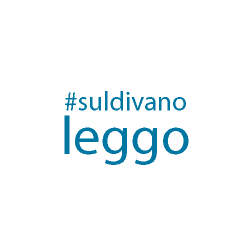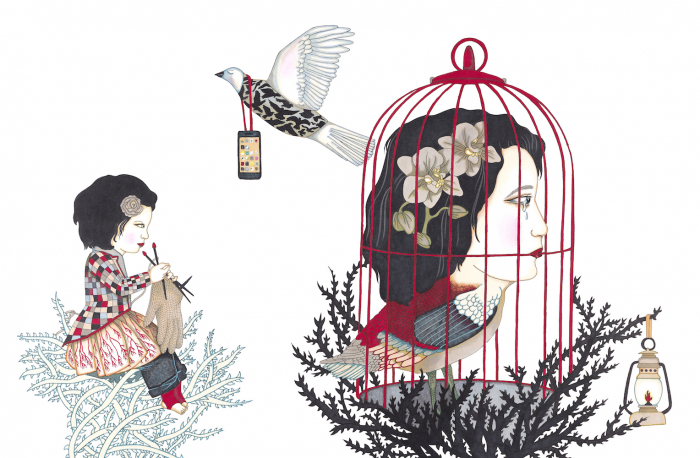When this number of ILLUSTRATI will be out, the 8th of March will be already gone by a week, but today, as I write down my thoughts on one of the books that moved me the most in the last few years, the date known as the Woman Day is just a few days away. As always, someone will jump on the opportunity to celebrate with friends and take a break from the exhausting routine, someone will promote thematic events and like every year the meaning behind this celebration will be the cause of countless debates. I personally believe in the importance of the community, therefore I welcome each occasion to gather together in order to remember, debate and strengthen the collective meaning of some important themes. This introduction might not look appropriate for a book focused on the mother and daughter relationship, where the poetic text is combined with exotic illustrations. However, this work can be analysed on several levels and I think that its political meaning is extremely fascinating. Many years ago, the traditional gender roles have been put under question, but the angel of the hearth stereotype risks to be replaced by a new cliché of superwoman, a woman who still takes on all her traditional tasks and at the same time excels in her studies and at work, successfully finds the time to keep in shape and gets involved in political or artistic activities. How many times the newspapers, when talking about scholars, musicians, writers, ministers and so on, specifically underline that these women are also perfectly able to look after an appropriate number of sons and daughters? This picture of the “well-performing feminine”, as I like to call it, is being added to the old representation of the mother and wife woman, which has never completely faded, and could become equally dangerous. Forced to share their time between the household and their jobs, loaded with a dizzy spiral of tasks, women are often overcome with fatigue, they feel inadequate and devoured by guilt.
For this reason, the mother pictured in Emmanuelle Houdart and Stéphane Servant’s book is a revolutionary figure. The cover illustration with oriental details represents her with closed eyes, the lips parted in a kiss, her hair growing as roots and multi-coloured birds which rest on her head; however, there is a note out of tune: her hands, embellished by the red polish, are dirty. Maybe she stained them while she was cooking in the kitchen or gardening, or maybe during one of the adventures we will discover in the next pages. What we know is that someone would define this woman as “not perfect”, because she is somehow untidy: while showing her best make up for the front cover, she nevertheless overlooked an important detail. In the next illustration, in the front flyleaf, we find again (a recurrent feature in the book) the woman’s side portrait while she narrates a story to the child in her womb. Mother and daughter are curled in a nest, surrounded by birds: the fantasy pattern on the mother’s dress, the little bird flying over the book, a hesitant penguin perched on the nest, who doesn’t know if he should stay or go, and the heron raising high. Who will be the next to leave the nest? Most probably the mother, because the child’s eyes are captivated by her mother’s features, while the woman is staring right in front of her, beyond the pages of the open book. Her glare precisely points between the flying heron and the hesitant penguin, two emblematic animals which represent her duality (in the next pages the she-wolf and the fox will make their appearance, as traditional symbols of cleverness and cunning).
The duality is a recurring element, from the very first verses: My mother’s heart is shared between the light of the sun and the dark of the night. In the same page, the mother is ready for her journey, her only baggage is a sword and some balls of wool, which suggest the double presence of traditional feminine and masculine roles. The theme is explored in the next illustration, in which we see her riding a fascinating monster towards new adventures. While she continues to peacefully knit, the open wound on her thigh hints to the battles she had to fight, a duality embodied also by the monster represented with an angelic face framed by wings and bird features with predatory eyes and ruddy horns. The mother combines masculine and feminine traits, she is a warrior and at the same time she takes care of the household; however she is not a superwoman. Actually, the tiniest detail can turn her laughter into joy and her sadness into a storm. She is not immune to moments of discouragement or sadness and she never hides her weaknesses. We see her smiling and crying, free as a bird or trapped in a cage. This complex and restless figure detaches herself from the sugar-coated and deified representations with watered down personalities that picture her as a static and reassuring mother, always committed to others.
She too needs to be comforted and attended to sometimes, as we see in the beautiful illustration that pictures her as a garden flourishing with love where thorns and wild plants are still growing. The traditional roles here are overthrown: the daughter and the father are taking care of her, of her plants that have been tamed through time. These illustrations, characterised by the neat lines and the vivid colours of Emmanuelle Houdart’s unique style, are always draped with small details that reveals themselves to a careful eye, like in a Chagall’s painting. Each picture constitutes a story within the story, therefore it should be read closely, taking all the necessary time. The visual harmony is given by the recurring representation of the duality that I have already mentioned, the theme of the journey, the ongoing communication through looks between the mother and the daughter which convey every subtle nuance of emotion with extreme delicacy. This is a love story after all, but for a change the mother’s love is not taken for granted: sweet moments are sprinkled with anxiety and the child’s fear to be abandoned. Even if we cannot stop to worry, there is a happy ending: in the last pages the mother declares her love for the child through warm words and two lovely illustrations. The child now knows she can count on her mother’s love and can relax, but she also truly understands her guide: the woman will continue to look ahead of her, to dream and suffer, to be in need of love and attention. In this small chef d’oeuvre, the two authors get rid of the classical feminine figure of the mother-woman, reassuring, rooted to the ground and faultless; at the same time, they reject the contemporary superwoman heroine. It’s a lesson to be learned for many women and men of every generation.
Mia madre
by Emmanuelle Houdart
#logosedizioni
hardcover, 28 pages, 200x275 mm
Italian
ISBN: 9788857608402

